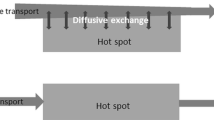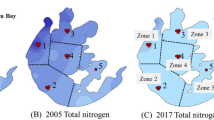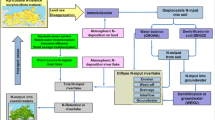Abstract
Floodplains play a crucial role in water quality regulation via denitrification. This biogeochemical process reduces nitrate (NO3−), with aquifer saturation, organic carbon (OC) and N availability as the main drivers. To accurately describe the denitrification in the floodplain, it is necessary to better understand nitrate fluxes that reach these natural bioreactors and the transformation that occurs in these surface areas at the watershed scale. At this scale, several approaches tried to simulate denitrification contribution to nitrogen dynamics in study sites. However, these studies did not consider OC fluxes influences, hydrological dynamics and temperature variations at a daily time step. This paper focuses on a new model that allows insights on nitrate, OC, discharge and temperature influences on daily denitrification for each water body. We used a process-based deterministic model to estimate daily alluvial denitrification in different watersheds showing various pedo-climatic conditions. To better understand global alluvial denitrification variability, we applied the method to three contrasting catchments: The Amazon for tropical zones, the Garonne as representative of the temperate climate and the Yenisei for cold rivers. The Amazon with a high discharge, frequent flooding and warm temperature, leads to aquifers saturation, and stable OC concentrations. Those conditions favour a significant loss of N by denitrification. In the Garonne River, the low OC delivery limits the denitrification process. While Arctic rivers have high OC exports, the low nitrate concentrations and cold temperature in the Yenisei River hinder denitrification. We found daily alluvial denitrification rates of 73.0 ± 6.2, 4.5 ± 1.4 and 0.7 ± 0.2 kgN ha−1 y−1 during the 2000–2010 period for the Amazon, the Garonne and the Yenisei respectively. This study quantifies the floodplains influence in the water quality regulation service, their contribution to rivers geochemical processes facing global changes and their role on nitrate and OC fluxes to the oceans.








Similar content being viewed by others
References
Abril G, Frankignoulle M (2001) Nitrogen–alkalinity interactions in the highly polluted Scheldt basin (Belgium). Water Res 35:844–850. https://doi.org/10.1016/S0043-1354(00)00310-9
Arnold JG, Srinivasan R, Muttiah RS, Williams JR (1998) Large area hydrologic modelling and assessment part 1: model development. J Am Water Resour Assoc 34:73–89. https://doi.org/10.1111/j.1752-1688.1998.tb05961.x
Baillieux A, Campisi D, Jammet N, Bucher S, Hunkeler D (2014) Regional water quality patterns in an alluvial aquifer: direct and indirect influences of rivers. J Contam Hydrol 169:123–131. https://doi.org/10.1016/j.jconhyd.2014.09.002
Batjes NH (2009) Harmonized soil profile data for applications at global and continental scales: updates to the WISE database. Soil Use Manag 25:124–127. https://doi.org/10.1111/j.1475-2743.2009.00202.x
Benoit M, Garnier J, Billen G (2015) Temperature dependence of nitrous oxide production of a luvisolic soil in batch experiments. Process Biochem 50:79–85. https://doi.org/10.1016/j.procbio.2014.10.013
Bernard-Jannin L, Sun X, Teissier S, Sauvage S, Sánchez-Pérez J-M (2017) Spatio-temporal analysis of factors controlling nitrate dynamics and potential denitrification hot spots and hot moments in groundwater of an alluvial floodplain. Ecol Eng 103:372–384. https://doi.org/10.1016/j.ecoleng.2015.12.031
Billen G, Garnier J, Lassaletta L (2013) The nitrogen cascade from agricultural soils to the sea: modelling nitrogen transfers at regional watershed and global scales. Philosoph Trans R Soc B Biol Sci 368:20130123–20130123. https://doi.org/10.1098/rstb.2013.0123
Billen G, Ramarson A, Thieu V, Théry S, Silvestre M, Pasquier C, Hénault C, Garnier J (2018) Nitrate retention at the river–watershed interface: a new conceptual modelling approach. Biogeochemistry 139:31–51. https://doi.org/10.1007/s10533-018-0455-9
Birgand F, Skaggs RW, Chescheir GM, Gilliam JW (2007) Nitrogen removal in streams of agricultural catchments—a literature review. Critic Rev Environ Sci Technol 37:381–487. https://doi.org/10.1080/10643380600966426
Boano F, Demaria A, Revelli R, Ridolfi L (2010) Biogeochemical zonation due to intrameander hyporheic flow: intrameander biogeochemical zonation. Water Resour Res. https://doi.org/10.1029/2008WR007583
Boyer EW, Alexander RB, Parton WJ, Li C, Butterbach-Bahl K, Donner SD, Skaggs RW, Grosso SJD (2006) Modelling denitrification in terrestrial and aquatic ecosystems at regional scales. Ecol Appl 16:2123–2142
Brin LD, Giblin AE, Rich JJ (2017) Similar temperature responses suggest future climate warming will not alter partitioning between denitrification and anammox in temperate marine sediments. Glob Change Biol 23:331–340. https://doi.org/10.1111/gcb.13370
Cakir R, Sauvage S, Gerino M, Volk M, Sánchez-Pérez JM (2020) Assessment of ecological function indicators related to nitrate under multiple human stressors in a large watershed. Ecol Ind 111:106016. https://doi.org/10.1016/j.ecolind.2019.106016
Canion A, Overholt WA, Kostka JE, Huettel M, Lavik G, Kuypers MMM (2014) Temperature response of denitrification and anaerobic ammonium oxidation rates and microbial community structure in Arctic fjord sediments: temperature and N cycling in Arctic sediments. Environ Microbiol 16:3331–3344. https://doi.org/10.1111/1462-2920.12593
Craig L, Bahr JM, Roden EE (2010) Localized zones of denitrification in a floodplain aquifer in southern Wisconsin, USA. Hydrogeol J 18:1867–1879. https://doi.org/10.1007/s10040-010-0665-2
de Ferranti J, Hormann C (2012) Digital Elevation Model
Du X, Loiselle D, Alessi DS, Faramarzi M (2020) Hydro-climate and biogeochemical processes control watershed organic carbon inflows: development of an in-stream organic carbon module coupled with a process-based hydrologic model. Sci Total Environ 718:137281. https://doi.org/10.1016/j.scitotenv.2020.137281
Elmi AA, Madramootoo C, Hamel C, Liu A (2003) Denitrification and nitrous oxide to nitrous oxide plus dinitrogen ratios in the soil profile under three tillage systems. Biol Fertil Soils 38:340–348. https://doi.org/10.1007/s00374-003-0663-9
European Commission (2003) Global Land Cover 2000 database
Fabre C, Sauvage S, Tananaev N, Srinivasan R, Teisserenc R, Sánchez Pérez J (2017) Using modeling tools to better understand permafrost hydrology. Water 9:418. https://doi.org/10.3390/w9060418
Fabre C, Sauvage S, Tananaev N, Noël GE, Teisserenc R, Probst JL, Sánchez-Pérez JM (2019) Assessment of sediment and organic carbon exports into the Arctic ocean: the case of the Yenisei River basin. Water Res 158:118–135. https://doi.org/10.1016/j.watres.2019.04.018
Ferrant S, Oehler F, Durand P, Ruiz L, Salmon-Monviola J, Justes E, Dugast P, Probst A, Probst J-L, Sanchez-Perez J-M (2011) Understanding nitrogen transfer dynamics in a small agricultural catchment: comparison of a distributed (TNT2) and a semi-distributed (SWAT) modelling approaches. J Hydrol 406:1–15. https://doi.org/10.1016/j.jhydrol.2011.05.026
Friedl J, Scheer C, Rowlings DW, McIntosh HV, Strazzabosco A, Warner DI, Grace PR (2016) Denitrification losses from an intensively managed sub-tropical pasture—impact of soil moisture on the partitioning of N2 and N2O emissions. Soil Biol Biochem 92:58–66. https://doi.org/10.1016/j.soilbio.2015.09.016
Fu B, Merritt WS, Croke BFW, Weber TR, Jakeman AJ (2019) A review of catchment-scale water quality and erosion models and a synthesis of future prospects. Environ Model Softw 114:75–97. https://doi.org/10.1016/j.envsoft.2018.12.008
Gift DM, Groffman PM, Kaushal SS, Mayer PM (2010) denitrification potential, root biomass, and organic matter in degraded and restored urban riparian zones. Restor Ecol 18:113–120. https://doi.org/10.1111/j.1526-100X.2008.00438.x
Groffman PM (2012) Terrestrial denitrification: challenges and opportunities. Ecol Process. https://doi.org/10.1186/2192-1709-1-11
Groffman PM, Altabet MA, Böhlke JK, Butterbach-Bahl K, David MB, Firestone MK, Giblin AE, Kana TM, Nielsen LP, Voytek MA (2006) Methods for measuring denitrification: diverse approaches to a difficult problem. Ecol Appl 16:2091–2122
Groffman PM, Butterbach-Bahl K, Fulweiler RW, Gold AJ, Morse JL, Stander EK, Tague C, Tonitto C, Vidon P (2009) Challenges to incorporating spatially and temporally explicit phenomena (hotspots and hot moments) in denitrification models. Biogeochemistry 93:49–77. https://doi.org/10.1007/s10533-008-9277-5
Guilhen J, Al Bitar A, Sauvage S, Parrens M, Martinez J-M, Abril G, Moreira-Turcq P, Sanchez-Pérez J-M (2020) Denitrification, carbon and nitrogen emissions over the Amazonianwetlands. Biogeochem Wetl. https://doi.org/10.5194/bg-2020-3
Guillemette F, del Giorgio PA (2011) Reconstructing the various facets of dissolved organic carbon bioavailability in freshwater ecosystems. Limnol Oceanogr 56:734–748. https://doi.org/10.4319/lo.2011.56.2.0734
Harrison MD, Groffman PM, Mayer PM, Kaushal SS, Newcomer TA (2011) Denitrification in Alluvial Wetlands in an Urban Landscape. J Environ Qual 40:634–646. https://doi.org/10.2134/jeq2010.0335
Hattermann FF, Krysanova V, Habeck A, Bronstert A (2006) Integrating wetlands and riparian zones in river basin modelling. Ecol Model 199:379–392. https://doi.org/10.1016/j.ecolmodel.2005.06.012
Helton AM, Poole GC, Payn RA, Izurieta C, Stanford JA (2014) Relative influences of the river channel, floodplain surface, and alluvial aquifer on simulated hydrologic residence time in a montane river floodplain. Geomorphology 205:17–26. https://doi.org/10.1016/j.geomorph.2012.01.004
Holmes RM, McClelland JW, Tank SE, Spencer RGM, Shiklomanov AI (2018) Arctic great rivers observatory. Water Quality Dataset. https://www.arcticgreatrivers.org/data
Hope D, Billett MF, Cresser MS (1994) A review of the export of carbon in river water: fluxes and processes. Environ Pollut 84:301–324. https://doi.org/10.1016/0269-7491(94)90142-2
Jégo G, Sánchez-Pérez JM, Justes E (2012) Predicting soil water and mineral nitrogen contents with the STICS model for estimating nitrate leaching under agricultural fields. Agric Water Manag 107:54–65. https://doi.org/10.1016/j.agwat.2012.01.007
Jung G, Wagner S, Kunstmann H (2012) Joint climate–hydrology modelling: an impact study for the data-sparse environment of the Volta Basin in West Africa. Hydrol Res 43:231–248. https://doi.org/10.2166/nh.2012.044
Leite NK, Krusche AV, Cabianchi GM, Ballester MVR, Victoria RL, Marchetto M, dos Santos JG (2011) Groundwater quality comparison between rural farms and riparian wells in the western Amazon, Brazil. Quim Nova 34:11–15. https://doi.org/10.1590/S0100-40422011000100003
Lu JZ, Zhang L, Cui XL, Zhang P, Chen XL, Sauvage S, Sanchez-Perez JM (2019) Assessing the climate forecast system reanalysis weather data-driven hydrological model for the Yangtze river basin in China. Appl Ecol Environ Res 17:3615–3632
Mayorga E, Seitzinger SP, Harrison JA, Dumont E, Beusen AHW, Bouwman AF, Fekete BM, Kroeze C, Van Drecht G (2010) Global Nutrient Export from WaterSheds 2 (NEWS 2): model development and implementation. Environ Modell Softw 25:837–853. https://doi.org/10.1016/j.envsoft.2010.01.007
McClain M, Richey J, Pimentel T (1994) Groundwater nitrogen dynamics at the terrestrial-lotic interface of a small catchment in the Central Amazon basin. Biogeochemistry. https://doi.org/10.1007/BF00002814
McClain ME, Boyer EW, Dent CL, Gergel SE, Grimm NB, Groffman PM, Hart SC, Harvey JW, Johnston CA, Mayorga E, McDowell WH, Pinay G (2003) Biogeochemical hot spots and hot moments at the interface of terrestrial and aquatic ecosystems. Ecosystems 6:301–312. https://doi.org/10.1007/s10021-003-0161-9
McLaughlin C, Kaplan LA (2013) Biological lability of dissolved organic carbon in stream water and contributing terrestrial sources. Freshw Sci 32:1219–1230. https://doi.org/10.1899/12-202.1
Meybeck M (1993) C, N, P and S in rivers: from sources to global inputs. In: Wollast R, Mackenzie FT, Chou L (eds) Interactions of C, N, P and S biogeochemical cycles and global change. Springer, Berlin, Heidelberg, pp 163–193
Moriasi DN, Arnold JG, Liew MWV, Bingner RL, Harmel RD, Veith TL (2007) model evaluation guidelines for systematic quantification of accuracy in watershed simulations. Trans ASABE 50:885–900. https://doi.org/10.13031/2013.23153
Moriasi DN, Gitau MW, Pai N, Daggupati P (2015) Hydrologic and water quality models: performance measures and evaluation criteria. Trans ASABE 58:1763–1785. https://doi.org/10.13031/trans.58.10715
Oeurng C, Sauvage S, Sánchez-Pérez J-M (2011) Assessment of hydrology, sediment and particulate organic carbon yield in a large agricultural catchment using the SWAT model. J Hydrol 401:145–153. https://doi.org/10.1016/j.jhydrol.2011.02.017
Parrens M, Al Bitar A, Frappart F, Papa F, Calmant S, Crétaux J-F, Wigneron J-P, Kerr Y (2017) Map** dynamic water fraction under the tropical rain forests of the Amazonian Basin from SMOS brightness temperatures. Water 9:350. https://doi.org/10.3390/w9050350
Parrens M, Kerr Y, Al Bitar A (2018) SWAF-HR: a high spatial and temporal resolution water surface extent product over the Amazon Basin. In: IGARSS 2018—2018 IEEE international geoscience and remote sensing symposium. Presented at the IGARSS 2018—2018 IEEE international geoscience and remote sensing symposium, IEEE, Valencia, pp 8389–8392. https://doi.org/10.1109/igarss.2018.8519079
Parrens M, Al Bitar AA, Frappart F, Paiva R, Wongchuig S, Papa F, Yamasaki D, Kerr Y (2019) High-resolution map** of inundation area in the Amazon basin from a combination of L-band passive microwave, optical and radar datasets. Int J Appl Earth Obs Geoinf 81:58–71. https://doi.org/10.1016/j.jag.2019.04.011
Peter S, Koetzsch S, Traber J, Bernasconi SM, Wehrli B, Durisch-Kaiser E (2012) Intensified organic carbon dynamics in the groundwater of a restored riparian zone: organic carbon in riparian aquifers. Freshw Biol 57:1603–1616. https://doi.org/10.1111/j.1365-2427.2012.02821.x
Peyrard D, Delmotte S, Sauvage S, Namour P, Gerino M, Vervier P, Sanchez-Perez JM (2011) Longitudinal transformation of nitrogen and carbon in the hyporheic zone of an N-rich stream: a combined modelling and field study. Phys Chem Earth Parts A/B/C 36:599–611. https://doi.org/10.1016/j.pce.2011.05.003
Pfeiffer SM, Bahr JM, Beilfuss RD (2006) Identification of groundwater flow paths and denitrification zones in a dynamic floodplain aquifer. J Hydrol 325:262–272. https://doi.org/10.1016/j.jhydrol.2005.10.019
Pinay G, Ruffinoni C, Wondzell S, Gazelle F (1998) Change in groundwater nitrate concentration in a large river floodplain: denitrification, uptake, or mixing? J N Am Benthol Soc 17:179–189. https://doi.org/10.2307/1467961
Ranalli AJ, Macalady DL (2010) The importance of the riparian zone and in-stream processes in nitrate attenuation in undisturbed and agricultural watersheds—a review of the scientific literature. J Hydrol 389:406–415. https://doi.org/10.1016/j.jhydrol.2010.05.045
Rathjens H, Oppelt N, Bosch DD, Arnold JG, Volk M (2015) Development of a grid-based version of the SWAT landscape model: development of a grid-based version of the SWAT landscape model. Hydrol Process 29:900–914. https://doi.org/10.1002/hyp.10197
Raymond PA, Bauer JE (2001) Use of 14 C and 13 C natural abundances for evaluating riverine, estuarine, and coastal DOC and POC sources and cycling: a review and synthesis. Org Geochem 32:469–485. https://doi.org/10.1016/S0146-6380(00)00190-X
EEA Report (2013) UWWTD data sources [WWW Document]. European Environment Agency. https://www.eea.europa.eu/themes/water/european-waters/water-use-and-environmental-pressures/uwwtd/uwwtd-data-sources. Accessed 27 Nov 2018
Rivett MO, Buss SR, Morgan P, Smith JWN, Bemment CD (2008) Nitrate attenuation in groundwater: a review of biogeochemical controlling processes. Water Res 42:4215–4232. https://doi.org/10.1016/j.watres.2008.07.020
Ruelland D, Billen G, Brunstein D, Garnier J (2007) SENEQUE: a multi-scaling GIS interface to the Riverstrahler model of the biogeochemical functioning of river systems. Sci Total Environ 375:257–273. https://doi.org/10.1016/j.scitotenv.2006.12.014
Saad OALO, Conrad R (1993) Temperature dependence of nitrification, denitrification, and turnover of nitric oxide in different soils. Biol Fertil Soils 15:21–27. https://doi.org/10.1007/BF00336283
Sánchez-Pérez JM, Trémolières M (2003) Change in groundwater chemistry as a consequence of suppression of floods: the case of the Rhine floodplain. J Hydrol 270:89–104. https://doi.org/10.1016/S0022-1694(02)00293-7
Sánchez-Pérez JM, Vervier P, Garabétian F, Sauvage S, Loubet M, Rols JL, Bariac T, Weng P (2003) Nitrogen dynamics in the shallow groundwater of a riparian wetland zone of the Garonne, SW France: nitrate inputs, bacterial densities, organic matter supply and denitrification measurements. Hydrol Earth Syst Sci Discuss 7:97–107
Sauvage S, Sánchez-Pérez J-M, Vervier P, Naiman R-J, Alexandre H, Bernard-Jannin L, Boulêtreau S, Delmotte S, Julien F, Peyrard D, Sun X, Gerino M (2018) Modelling the role of riverbed compartments in the regulation of water quality as an ecological service. Ecol Eng 118:19–30. https://doi.org/10.1016/j.ecoleng.2018.02.018
Seitzinger S, Harrison JA, Böhlke JK, Bouwman AF, Lowrance R, Peterson B, Tobias C, Drecht GV (2006) Denitrification across landscapes and waterscapes: a synthesis. Ecol Appl 16:2064–2090
Smith K (1997) The potential for feedback effects induced by global warming on emissions of nitrous oxide by soils. Glob Change Biol 3:327–338. https://doi.org/10.1046/j.1365-2486.1997.00100.x
Søndergaard M, Middelboe M (1995) A cross-system analysis of labile dissolved organic carbon. Mar Ecol Prog Ser 118:283–294. https://doi.org/10.3354/meps118283
Sun X (2015) Modélisation des échanges nappe-rivière et du processus de dénitrification dans les plaines alluviales à l’échelle du bassin versant (PhD Thesis)
Sun X, Bernard-Jannin L, Grusson Y, Sauvage S, Arnold J, Srinivasan R, Sánchez-Pérez J (2018) Using SWAT-LUD model to estimate the influence of water exchange and shallow aquifer denitrification on water and nitrate flux. Water 10:528. https://doi.org/10.3390/w10040528
Tenuta M, Sparling B (2011) A laboratory study of soil conditions affecting emissions of nitrous oxide from packed cores subjected to freezing and thawing. Can J Soil Sci 91:223–233. https://doi.org/10.4141/cjss09051
Thouvenot-Korppoo M, Billen G, Garnier J (2009) Modelling benthic denitrification processes over a whole drainage network. J Hydrol 379:239–250. https://doi.org/10.1016/j.jhydrol.2009.10.005
Observation Service SO HYBAM, n.d. Observation Service for the geodynamical, hydrological and biogeochemical control of erosion/alteration and material transport in the Amazon, Orinoco and Congo basins
Yamazaki D, Kanae S, Kim H, Oki T (2011) A physically-based description of floodplain inundation dynamics in a global river routing model: floodplain inundation dynamics. Water Resour Res. https://doi.org/10.1029/2010WR009726
Zaman M, Nguyen ML, Simek M, Nawaz S, Khan MJ, Babar MN, Zaman S (2012) Emissions of nitrous oxide (N2O) and dinitrogen (N2) from the agricultural landscapes, sources, sinks, and factors affecting N2O and N2 ratios. In: Greenhouse gases-emission, measurement and management. IntechOpen
Zarnetske JP, Haggerty R, Wondzell SM, Baker MA (2011) Labile dissolved organic carbon supply limits hyporheic denitrification. J Geophys Res. https://doi.org/10.1029/2011JG001730
Zarnetske JP, Haggerty R, Wondzell SM, Bokil VA, González-Pinzón R (2012) Coupled transport and reaction kinetics control the nitrate source-sink function of hyporheic zones: hyporheic N source-sink controls. Water Resour Res. https://doi.org/10.1029/2012WR011894
Acknowledgements
We do acknowledge the Observation Service SO HYBAM, the French Water Agency, Electricité De France (project REGARD-RTRA/STAE), Compagnie d’Aménagement des Coteaux de Gascogne, Banque Hydro, the Arctic Great Rivers Observatory and the TOMCAR-Permafrost Project for the sharing of their data on DOC, nitrate and daily discharge in the studied watersheds. This work is part of the governmental PhD program of Clément Fabre.
Funding
This research did not receive any specific grant from funding agencies in the public, commercial, or not-for-profit sectors.
Author information
Authors and Affiliations
Contributions
C.F., J.G., S.S. and J.M.S.P. designed and developed the model with the help of R.C. C.F. performed and analyzed the modelling. C.F. wrote the paper with considerable contributions from J.M.S.P., S.S.; J.G., M.G. and R.C.
Corresponding authors
Additional information
Responsible Editor: R. Kelman Wieder
Publisher's Note
Springer Nature remains neutral with regard to jurisdictional claims in published maps and institutional affiliations.
Appendix 1: Daily DOC fluxes exported at the outlet of (a) the Amazon River, (b) the Garonne River and (c) the Yenisei River. The Yenisei graph is adapted from Fabre et al. (2019). Locations of the sampling stations are found in Fig. 1
Rights and permissions
About this article
Cite this article
Fabre, C., Sauvage, S., Guilhen, J. et al. Daily denitrification rates in floodplains under contrasting pedo-climatic and anthropogenic contexts: modelling at the watershed scale. Biogeochemistry 149, 317–336 (2020). https://doi.org/10.1007/s10533-020-00677-4
Received:
Accepted:
Published:
Issue Date:
DOI: https://doi.org/10.1007/s10533-020-00677-4





